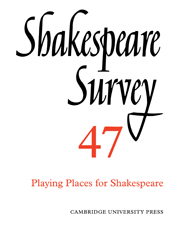Book contents
- Frontmatter
- Shakespeare Played Small: Three Speculations about the Body
- The Architecture of the Fortune Playhouse
- The Bare Island
- ‘How Chances it they Travel?’ Provincial Touring, Playing Places, and the King’s Men
- Writing for the Metropolis: Illegitimate Performances of Shakespeare in Early Nineteenth-Century London
- The Perishable Body of the Unpoetic: A. C. Bradley Performs Othello
- Playing Places for Shakespeare: The Maddermarket Theatre, Norwich
- ‘A Fairly Average Sort of Place’: Shakespeare in Northampton, 1927–1987
- The Living Monument: Self and Stage in the Criticism and Scholarship of M. C. Bradbrook
- Stratford Stages: Interviews with Michael Reardon and Tim Furby, and Sam Mendes
- Dis-Covering the Female Body: Erotic Exploration in Elizabethan Poetry
- Theseus’ Shadows in A Midsummer Night’s Dream
- ‘Time for Such a Word’: Verbal Echoing in Macbeth
- Shakespeare’s Knowledge of Italian
- Tamburline and Edward Alleyn’s Ring
- Shakespeare Performances in England, 1992–1993
- Professional Shakespeare Productions in the British Isles, January-December 1992
- The Year's Contributions to Shakespeare Studies 1 Critical Studies
- 2 Shakespeare’s Life, Times, and Stage
- 3 Editions and Textual Studies
- Books Received
- Index
The Bare Island
Published online by Cambridge University Press: 28 March 2007
- Frontmatter
- Shakespeare Played Small: Three Speculations about the Body
- The Architecture of the Fortune Playhouse
- The Bare Island
- ‘How Chances it they Travel?’ Provincial Touring, Playing Places, and the King’s Men
- Writing for the Metropolis: Illegitimate Performances of Shakespeare in Early Nineteenth-Century London
- The Perishable Body of the Unpoetic: A. C. Bradley Performs Othello
- Playing Places for Shakespeare: The Maddermarket Theatre, Norwich
- ‘A Fairly Average Sort of Place’: Shakespeare in Northampton, 1927–1987
- The Living Monument: Self and Stage in the Criticism and Scholarship of M. C. Bradbrook
- Stratford Stages: Interviews with Michael Reardon and Tim Furby, and Sam Mendes
- Dis-Covering the Female Body: Erotic Exploration in Elizabethan Poetry
- Theseus’ Shadows in A Midsummer Night’s Dream
- ‘Time for Such a Word’: Verbal Echoing in Macbeth
- Shakespeare’s Knowledge of Italian
- Tamburline and Edward Alleyn’s Ring
- Shakespeare Performances in England, 1992–1993
- Professional Shakespeare Productions in the British Isles, January-December 1992
- The Year's Contributions to Shakespeare Studies 1 Critical Studies
- 2 Shakespeare’s Life, Times, and Stage
- 3 Editions and Textual Studies
- Books Received
- Index
Summary
When Prospero begs the audience not to spellbind him ‘in this bare island’ it is not unreasonable to wonder where we are supposed to think we are. From the unique and startling shipwreck scene that set us on shore to that unique and peculiar octosyllabic Epilogue, we have been on an island full of noises and magic that hurt not. At the end, after the ‘Exeunt all’, the courtiers still in their clothes for Claribel’s wedding, the seamen dry again, and Prospero’s robe, book and staff all gone, Prospero speaks his last speech bare of his trappings. Is his adjective a transferred epithet? I think not, even in the wake of all the colourful apparel that has just walked offstage. Prospero stands alone on the stage island in the middle of a sea of offaces, asking for human breath to blow his sail to Naples, if he is not to be imprisoned on the island. Like Hamlet’s ground, that other ‘stale promontory’, Prospero’s stage island has lost its fresh decorations. What, in the original performances, was it bared of, though? A lot of people, certainly, some of them colourfully dressed. Prospero’s own props, his magic gown and staff, must have gone too. Was the stage shorn of fabric and colour? Was it all bare boards? Were there no hangings left across the front of the tiring house and Prospero’s cell? Was there no painting on the stage posts to make them look like marble as De Witt described them? It would be nice to know. For all the riches of the recent archaeological findings, the Shakespearian mise en scène, the geography of the stage island, is not so much bare as undiscovered.
- Type
- Chapter
- Information
- Shakespeare Survey , pp. 29 - 44Publisher: Cambridge University PressPrint publication year: 1994
- 2
- Cited by

